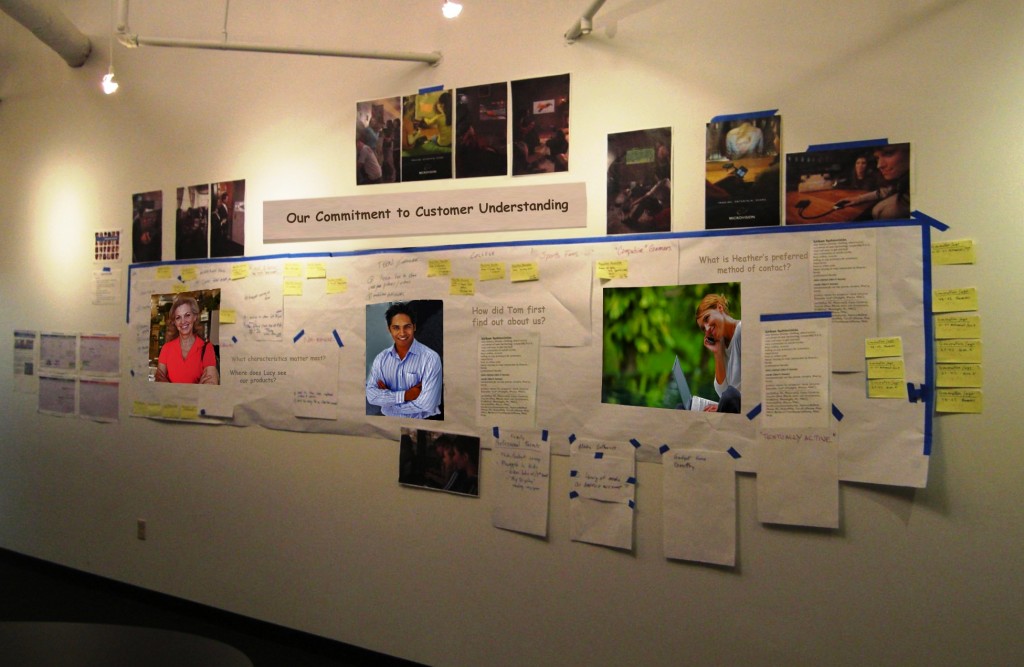
Customers are the lifeblood of your organization. Delighting them is your surest path to sustainable success. When you make the customer come alive inside your organization you leverage employees natural empathy, focus employees on what customers value and provide them with a shared purpose. This renewed understanding and engagement may unlock the answers to some of your most vexing problems and give you insights into profitable growth opportunities.
7 Steps to Make the Customer Come Alive Inside Your Organization
- create a dedicated space to demonstrate customer thinking – a wall works.
- place photos of typical customers – could be other stakeholders depending on your business and focus, e.g. investors, prospects, employees, partners, patients, members, guests, visitors, volunteers, voters, citizens, students, clients, etc.
- ask and answer questions –
- how did they become aware of us?
- what are their communications habits?
- why did they buy from us?
- what are their needs and are they changing?
- enroll others in an ongoing dialogue around customers – encourage colleagues to place sticky notes or write on the wall
- continue to gain new insights and generate new questions
- as you have customer interactions share your learning at the wall
- prioritize and take action on insights – you can’t do it all so focus on the projects and programs that will have the most impact and look for quick wins.
Other Projects that can help you improve your Customer Thinking and eliminate blind spots include: net promoter score (NPS) & loyalty strategy; customer evidence (case studies, testimonials, references); customer observation, behavior, and needs analysis; segmentation and ecosystem mapping; customer storybook and voice of the customer; win/loss/stall analysis; empathy lab; and customer profitability & retention analysis.


 Everything has changed, but you’re still executing on the old strategy? Chances are you’ve been too busy to re-examine your strategy, let alone change course. Like most organizations you’ve completed your annual planning and you’re on cruise control –Set it and Forget. Of course, you’ll revisit the strategy in next year’s annual planning session. But what happens when you’re cruising down the road and a competitor, customer, partner, or legislation throws the proverbial monkey wrench in your spokes. Right – your organization will react to it when you encounter that problem. If that is what you believe, then you’ve fallen into the trap. That’s the thing, you can only react to those things you are aware of. Most things that erode your business are more subtle than the abrupt, spoke shearing monkey wrench. Think of a hidden killer like pancreatic cancer. You don’t have years of leading indicators. When it is too late, it is sadly, too late.
Everything has changed, but you’re still executing on the old strategy? Chances are you’ve been too busy to re-examine your strategy, let alone change course. Like most organizations you’ve completed your annual planning and you’re on cruise control –Set it and Forget. Of course, you’ll revisit the strategy in next year’s annual planning session. But what happens when you’re cruising down the road and a competitor, customer, partner, or legislation throws the proverbial monkey wrench in your spokes. Right – your organization will react to it when you encounter that problem. If that is what you believe, then you’ve fallen into the trap. That’s the thing, you can only react to those things you are aware of. Most things that erode your business are more subtle than the abrupt, spoke shearing monkey wrench. Think of a hidden killer like pancreatic cancer. You don’t have years of leading indicators. When it is too late, it is sadly, too late.
 Timely and relevant communications is essential for businesses to reach their target audience. Anything less is noise that will largely go unnoticed or worse irritate the intended audience. Sadly, many organizations fall into the trap of poorly segmenting communications. Sales and even some marketing personnel fail to differentiate between suspects, prospects, and customers. When this happens, loyal customers are often overlooked. Think how a loyal customer feels about your brand when prospects receive better offers than they do. This results in customer churn, diminished sales, and poor loyalty.
Timely and relevant communications is essential for businesses to reach their target audience. Anything less is noise that will largely go unnoticed or worse irritate the intended audience. Sadly, many organizations fall into the trap of poorly segmenting communications. Sales and even some marketing personnel fail to differentiate between suspects, prospects, and customers. When this happens, loyal customers are often overlooked. Think how a loyal customer feels about your brand when prospects receive better offers than they do. This results in customer churn, diminished sales, and poor loyalty.